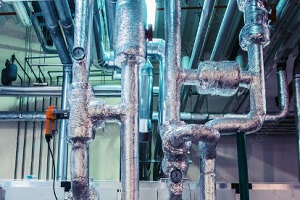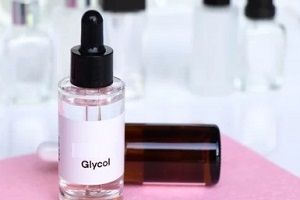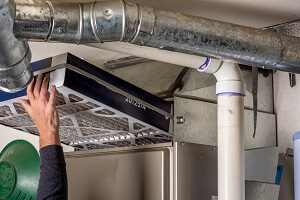 Maintaining a glycol water system is crucial for ensuring the efficient operation of your HVAC system. Glycol, a type of antifreeze, is added to the water in these systems to prevent freezing and overheating. Glycol however, requires a certain level of maintenance and you cannot just “set it and forget it”.
Maintaining a glycol water system is crucial for ensuring the efficient operation of your HVAC system. Glycol, a type of antifreeze, is added to the water in these systems to prevent freezing and overheating. Glycol however, requires a certain level of maintenance and you cannot just “set it and forget it”.
Here’s how to maintain your glycol water system so that you’re not blindsided by unexpected freezes and pipes bursting in the cold weather.
Have Your Glycol Tested by a Professional
You’ll need a professional to help you identify how your system’s glycol is currently functioning. Regular glycol system maintenance is critical for continued performance and should be conducted quarterly by a water treatment expert.
A professional will examine the overall level of glycol in your system, but they’ll also be looking for other indicators that the compound is no longer working correctly. If your glycol system is not maintained regularly, your system could freeze without warning, causing substantial damage to the pipes and equipment within.
Understand the Following
Your water treatment vendor should be visiting your facility to test your system every three months or so. However, if you encounter any of the following problems in the interim, be sure to reach out for help sooner if you notice:
- Unusual odors in water
- Unusual color of water
- An unusual change in your water’s temperature or system pressure across the air handlers or exchangers
- More frequent filter changes than usual
Understanding the following items will help you with the maintenance of your system, and help to avoid any issues mentioned above.
Acid Content (Useful Life of Glycol)
 Glycol does not last forever. The substance itself will break down over time with regular use and convert into an acid. If your system has a higher acid content than you expect, it could indicate that your glycol has reached the end of its useful life and needs to be replaced.
Glycol does not last forever. The substance itself will break down over time with regular use and convert into an acid. If your system has a higher acid content than you expect, it could indicate that your glycol has reached the end of its useful life and needs to be replaced.
If it is not replaced, the acid can corrode the metal components of the system, lead to the formation of sludge, which can clog the system, and cause the system to lose its ability to effectively transfer heat, decreasing performance.
Bacteria (Contamination of Glycol)
Bacteria can contaminate glycol in your system through a variety of ways. One common method is through the formation of biofilm within the system. Biofilm is a thin layer of microorganisms that adhere to surfaces and forms on the inside of pipes.
Bacteria can also enter the system by neglecting regular maintenance and inspection, not properly draining or cleaning the system, or by not monitoring the pH of the glycol. Your water treatment professional should be able to test, detect, and address any bacterial issues by testing the glycol mixture and adding biocides or suggesting a flush if needed.
Corrosion Inhibitors (Protects Metal in System)
As mentioned previously, the glycol in your system is added alongside corrosion inhibitors to stop your pipes from corroding over time. Corrosion inhibitors are chemicals added to a glycol system to protect the metal components from breaking down.
They work by forming a protective layer on the metal surfaces, and neutralize any acids that may be present in the system. If experts notice during testing that you have high levels of metal in your water, it could indicate that the inhibitors are no longer working like they should.
pH & Alkalinity (Stability of Glycol)
Regular monitoring of the pH and alkalinity levels in a glycol system is important to ensure the longevity and performance of the system. The pH level of the glycol solution is an indicator of the acidity or basicity of the solution. A pH that is either too acidic or too basic can damage the metal components of the system.
Additionally, certain types of bacteria thrive in certain pH ranges, so monitoring pH can also help detect bacterial contamination. Alkalinity is a measure of the ability of a solution to neutralize acids. A low alkalinity level can indicate that the corrosion inhibitors in the system are not functioning properly and that additional inhibitors should be added.
Percentage & Concentration (Freeze Protection/Boiling Point)
The glycol concentration percentage is important to know because it affects the freezing point of the fluid in the system. As the concentration of glycol increases, the freezing point of the fluid decreases. This allows the system to operate at lower temperatures and in colder environments.
However, if the concentration is too high, it can cause corrosion and scaling in the system, and if it is too low, your fluid may freeze, preventing it from operating at low temperatures. This can cause damage to the system and decrease its performance. Your water treatment company should be able to maintain the correct glycol concentration to ensure the system is operating efficiently and safely.
Check or Replace Filters
 Filters are used to remove contaminants such as dirt and debris from the fluid in the system. This helps to maintain the quality of the fluid and protect the system from damage caused by these contaminants. Regularly checking and replacing filters can help to improve system performance by reducing the amount of solids or byproducts in the water.
Filters are used to remove contaminants such as dirt and debris from the fluid in the system. This helps to maintain the quality of the fluid and protect the system from damage caused by these contaminants. Regularly checking and replacing filters can help to improve system performance by reducing the amount of solids or byproducts in the water.
A buildup of solids in your filter can slow down flow, and cause your machinery to work harder to push water through your building. Keeping up with regular filter replacement can help avoid costly repairs, downtime, and maintain lower energy costs.
Hire a Professional For Your Glycol System Maintenance
It is critical that you stay on top of maintenance for your glycol water system however, it can be difficult to know exactly when adjustments need to be made. The experts at Tower Water can help you maintain your glycol water system and tackle any problems before they arise. Contact us today at (212) 518-6475 for more information on how we can help.
